1Z0-144 Online Practice Questions and Answers
View the exhibit and examine the structure of the products table.
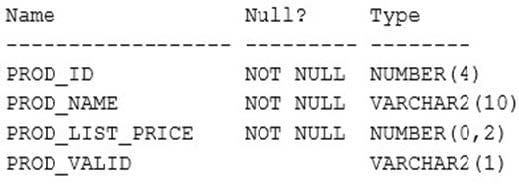
Examine the following code: Which statement is true when the procedure DELETE_DETAILS is invoked?
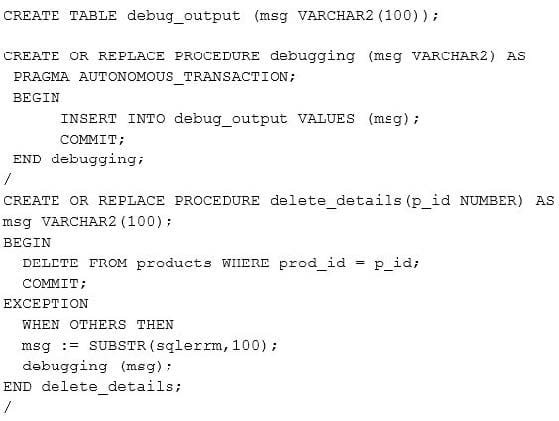
A. It executes successfully but no error messages get recorded in the DEBUG_OUTPUT table
B. It executes successfully and any error messages get recorded in the DEBUG_OUTPUT table.
C. It gives an error because PRAGMA AUTONOMOUS_TRANSACTION can be used only in packaged procedures.
D. It gives an error because procedures containing PRAGMA AUTONOMOUS_TRANSACTION cannot be called from the exception section.
Examine the following code:

Which two statements are true about the above function? (Choose two.)
A. It can be used only in a parallelized query.
B. It can be used in both a parallelized query and a parallelized DML statement.
C. It can be used only in a parallelized data manipulation language (DML) statement.
D. It can have a separate copy run in each of the multiple processes when called from a SQL statement that is run in parallel.
E. It requires a PRAGMA RESTRICT_REFERENCES declaration with RNDS, WNDS, RNPS, and WNPS specified in order to use parallel optimization.
User SCOTT has been granted CREATE ANY TRIGGER and ALTER ANY TABLE by the DBA. HR is an
existing schema in the database.
SCOTT creates the following trigger:
CREATE OR REPLACE TRIGGER drop_trigger
BEFORE DROP ON hr.SCHEMA
BEGIN
RAISE_APPLICATION_ERROR (-20000, `Cannot drop object');
END;
SCOTT does not grant the EXECUTE privilege on this trigger to any other users.
For which user(s) would this trigger fire by default when they drop an object in the HR schema?
A. Only HR
B. SCOTT and HR
C. Only SCOTT
D. SCOTT, HR, and SYS
Examine the following snippet of PL/SQL code:

View the Exhibit for table description of EMPLOYEES table. The EMPLOYEES table has 200 rows.
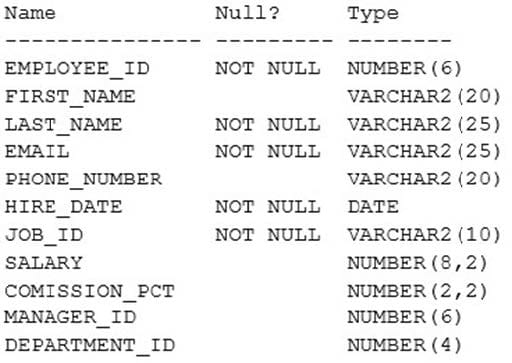
Identify OPEN statements for opening the cursor that fetches the result set consisting of employees with JOB_ID as `ST_CLERK' and SALARY greater than 3000. (Choose three.)
A. OPEN c1 (NULL, 3000);
B. OPEN c1 (emp_job, 3000);
C. OPEN c1 (3000, emp_salary);
D. OPEN c1 (`ST_CLERK', 3000)
E. OPEN c1 (emp_job, emp_salary);
Examine the following package specification.
SQL>CREATE OR REPLACE PACKAGE emp_pkf IS PROCEDURE search_emp (empdet NUMBER); PROCEDURE search_emp (empdet DATE); PROCEDURE search_emp (empdet NUMBER); RETURN VERCHAR2 PROCEDURE search_emp (empdet NUMBER); RETURN DATE END emp_pkg /
The package is compiled successfully
Why would it generate an error at run tune?
A. Because function cannot be overload.
B. Because function cannot differ only in return type.
C. Because all the functions and procedures in the package cannot have the same number of parameters with the same parameter name.
D. Because the search EMP (EMPDET NUMBER) procedure and the SEARCH_DEPT (EMPDET NUMBER) cannot have identical parameter names and data types.
Examine the following partial code:

Which statement is correct about the unnamed block of code at the end of a package body?
A. It generates an error because all the blocks of code in a package body must be named.
B. It generates an error because V_TAXRATE is a public variable that is already initialized in the package specification.
C. It acts as a package initialization block that executes once, when the package is first invoked within the user session.
D. It acts as a package initialization block that executes each time a package subprogram is invoked within the user session and refreshes the initialized variable's value.
Examine the following PL/SQL code: Which statement is true about the fetch statements in the PL/SQL code?
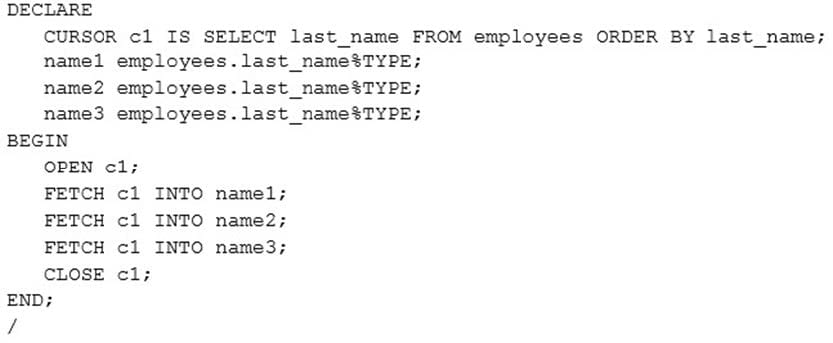
A. Each fetch retrieves the first row and assigns values to the target variables.
B. Each fetch retrieves the next consecutive row and assigns values to the target variables.
C. They produce an error because you must close and reopen the cursor before each fetch -statement.
D. Only the first fetch retrieves the first row and assigns values to the target variables- the second produces an error.
Which two statements are true about anonymous blocks and named subprograms? (Choose two.)
A. Subprograms are by default executed with definer's rights.
B. The declare section is optional for both anonymous blocks and subprograms.
C. Both anonymous blocks and subprograms execute by default with invoker's rights.
D. The declare section is mandatory for anonymous blocks and optional for subprograms.
Examine the following DECLARE section of PL/SQL block:
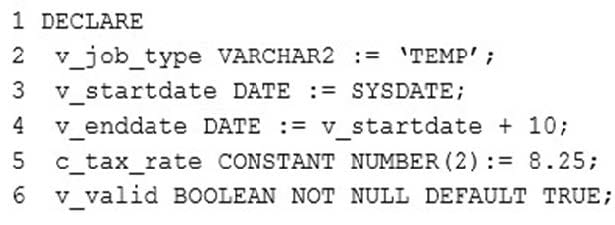
Which line in the above declarations would generate an error?
A. Line 2
B. Line 3
C. Line 4
D. Line 5
E. Line 6
Which two statements are true about database triggers? (Choose two.)
A. Each trigger can be of any size.
B. Each trigger can be of a maximum size of 32 KB.
C. A trigger can contain a maximum of 32 lines of code.
D. Triggers fired by DML statements cannot cascade simultaneously.
E. Both DML and DDL statements can cascade any number of triggers.
F. Both data manipulation language (DML) and data definition language (DDL) statements can cascade up to 32 triggers.

